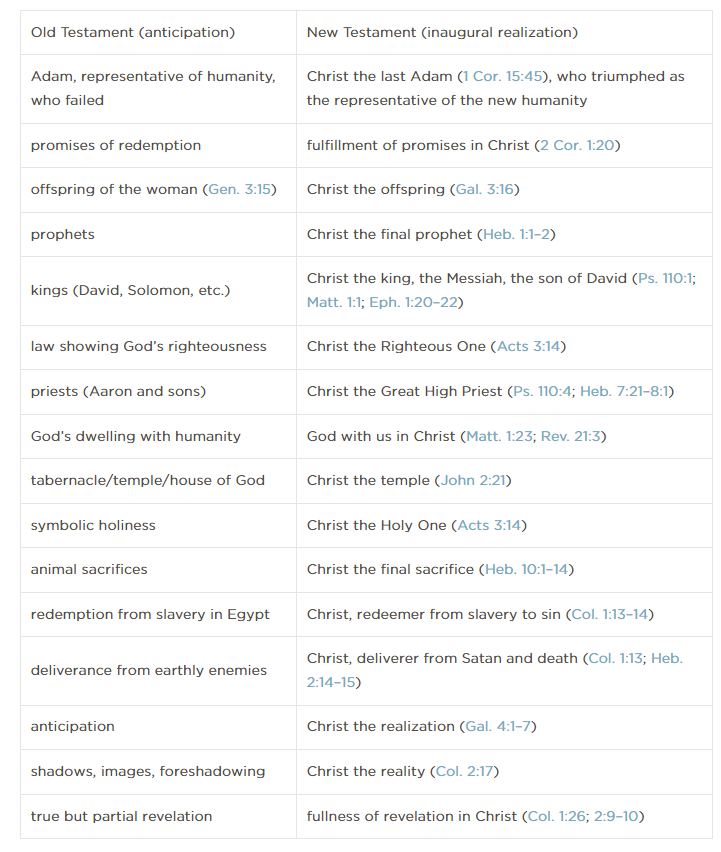The books of the Old Testament and the New Testament were written by different human authors over a long span of time. But they share profound unities.
Unities
Every book in the Bible has God as the divine author, who inspired each human author. All of Scripture is the very Word of God.
All of the Bible is Trinitarian communication to us. God the Father speaks all of the words through the Son, the eternal Word (John 1:1), and God speaks in the power and means of the Holy Spirit (2 Pet. 1:21).
All of the Bible is Christ-centered. Christ is the central subject and focus of the Bible. This focus is obvious in the New Testament, but it is present in the Old Testament also (Luke 24:25–27, 44–47; John 5:39–40, 45–47; 1 Pet. 1:10–12).
The Bible reveals how God redeems his people. Its focus is salvation as it applies to individuals and also to God’s people as a corporate unity.
The Bible bears a unified message of salvation. The fall of Adam (Gen. 3:6–7) resulted in sinfulness coming to the whole human race, Christ excepted. There is only one way of rescue, namely, Christ himself: “Jesus said . . . , ‘I am the way, and the truth, and the life. No one comes to the Father except through me’” (John 14:6). People cannot make up for their sins by accumulating good works, because God is perfectly holy, and sins must receive judgment by the Father, who is just. Only Christ, who was also perfectly holy, can bear the burden of the penalty for sins (1 Pet. 2:24).
This principle that salvation comes only in Christ is obvious in the New Testament but found in the Old Testament also. Before Christ came, sins were forgiven for the sake of Christ’s future work (Rom. 3:25; Heb. 10:4, 10). Saved people in the Old Testament believed in God’s promise of a Redeemer and enjoyed communion with God. He applied to them beforehand benefits based on what Christ would accomplish.
Two Epochs
The Old and New Testaments differ because they stand on the two sides of the center-point of history, the coming of Christ. The Old Testament sets forth the earlier part of the history of redemption, with anticipations of Christ. God was working all of history together to lead up to the time at which Christ would come (Gal. 4:4). The New Testament sets forth the later course of history, looking back on Christ’s redemption accomplished in his life, death, resurrection, and exaltation. And the New Testament also encourages Christians by reminding them to live in light of his present-day reign and his future return.
Christ’s death and resurrection brought the turning point in history, moving us from a previous age, the “present evil age” (Gal. 1:4), into the inaugural stage of the “age to come” (Heb. 6:5), characterized by Christ’s victory over sin and death (Heb. 2:14–15). Jesus’ earthly ministry inaugurated the kingdom of God (Matt. 12:28), and it continues now toward its culmination through Christ’s rule over those who belong to him (Rom. 14:17; Col. 1:13).
God’s Timeline
God works out his plan in history:
God’s eternal plan (Eph. 1:4; 1 Pet. 1:20);
creation (Genesis 1–2);
the fall (Genesis 3);
the promise and anticipation of redemption (the Old Testament);
the accomplishment of redemption (the life, death, and resurrection of Christ, recorded in the Gospels; the ascension and reign of Christ in Acts; his work further explained in the Epistles);
the application of the redemption and the inclusion of the Gentiles (Acts);
the second coming, the close of this age (1 Corinthians 15; Revelation 19–22).
This is a unified and comprehensive plan: “There is one God, and there is one mediator between God and men, the man Christ Jesus, who gave himself as a ransom for all, which is the testimony given at the proper time” (1 Timothy 2:5–6).
Differences and Correspondences between the Two Testaments
The Old Testament differs from the New Testament because Christ had not yet come. But it also corresponds to the New Testament in giving promises and signs pointing forward to his coming. We can see many correspondences:

Law and Gospel
The Ten Commandments and other laws in the Old Testament also point forward to Christ. God’s commandments function in several ways. Such laws:
reflect God’s holy and righteous character;
convict us of sin and guilt, convince us of our spiritual inability, and drive us to see the need for Christ the Redeemer;
reflect the righteousness of Christ;
guide us in the way of Christ.
The gospel of Christ, proclaimed in the Old Testament in promises and signs, is proclaimed in the New Testament by announcing what Christ has accomplished for us in fulfilling the Old Testament.

Key Themes:
Jesus. Jesus is God, the “I am.” He existed before the creation of the world, and he has supernatural knowledge. He fulfills the Jewish festivals and institutions. As the sent Son of God, he reflects the Sender. Signs and witnesses demonstrate that he is the Messiah.
The Trinity. Father, Son, and Spirit are united in their work of revelation and redemption.
Salvation. God is sovereign in salvation. Jesus’ death is the basis of salvation, which is obtained through believing in the living Jesus as the Son of God.
Eternal Life. Jesus is the giver of eternal life. Believers can experience some of salvation’s benefits during this present evil age.
Mission. Believers are called to continue Jesus’ mission.
References:
All contents are reposted from ESV.org.
“Scripture quotations are from The ESV® Bible (The Holy Bible, English Standard Version®), copyright © 2001 by Crossway, a publishing ministry of Good News Publishers. Used by permission.
All rights reserved.”
Kommentare